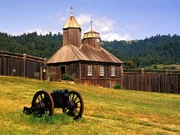No edit summary |
mNo edit summary |
||
| Line 67: | Line 67: | ||
[[File:Fort-Ross.jpg|thumb|left|Preserved buildings of {{W|Fort Ross}}.]] |
[[File:Fort-Ross.jpg|thumb|left|Preserved buildings of {{W|Fort Ross}}.]] |
||
| − | During the {{RA| |
+ | During the {{RA|Great Western War}} (1822-1824), the Russian colony suffered damage by the {{RA|Spain|Spanish}}. The war concluded with the {{RA|Russian Empire}} gaining full control of the area. The {{W|Post-war|postbellum era}} would see the development of the Ross Colony into a major trading post on the {{W|Pacific Ocean}}. The colony was incorporated into a city in 1832 and would become a regional hub during the {{W|California Gold Rush|Gold Rush}} of the 1850s. Ross would serve as the end of the {{W|Russian–American Telegraph}} and the {{W|First Transcontinental Railroad}}. |
By the {{W|20th Century}}, Ross had developed into a major city within the {{RA|Russian Empire}}. The city would also form the epicenter of {{RA|Alaska}}'s and {{RA|Sonoma}}'s {{W|Independence|independence movements}}. Beginning in 1921, the city would come under the control of the {{W|Soviet (council)|Ross Soviet}} — a {{W|Democracy|democratic council}} headed by the citizens of the city. It was also during this time that the {{RA|Governorates of Alaska|gubernial capital}} of {{RA|Sonoma}} was moved to {{W|Dos Rios, California|Dvurechki}} in the north. |
By the {{W|20th Century}}, Ross had developed into a major city within the {{RA|Russian Empire}}. The city would also form the epicenter of {{RA|Alaska}}'s and {{RA|Sonoma}}'s {{W|Independence|independence movements}}. Beginning in 1921, the city would come under the control of the {{W|Soviet (council)|Ross Soviet}} — a {{W|Democracy|democratic council}} headed by the citizens of the city. It was also during this time that the {{RA|Governorates of Alaska|gubernial capital}} of {{RA|Sonoma}} was moved to {{W|Dos Rios, California|Dvurechki}} in the north. |
||
Revision as of 16:27, 15 November 2019
Гром победы, раздавайся! (Russian) ("Let the Thunder of Victory Rumble!") | |||||||
| Country | |||||||
| Governorate | |||||||
| Language official |
Russian (de facto) | ||||||
| others | Chinese, Greek, Spanish | ||||||
| Religion main |
Eastern Orthodox and Jews | ||||||
| others | Buddhists, Eastern Catholics | ||||||
| Ethnic groups main |
Chinese and Ukrainians | ||||||
| others | Armenians, Greeks, Russians | ||||||
| Demonym | Ruthenite • Rossets | ||||||
| Founded | September 11, 1812 | ||||||
| Incorporated | 1832 | ||||||
| Gradonachalnik | Pavel Krekoryan (DMS) | ||||||
| Area | 1,210 km² (1,063 кв. врс) | ||||||
| Population | 2,714,856 (2017 Census) | ||||||
| Time zone | BLT (UTC-8) | ||||||
| summer | BLST (UTC-7) | ||||||
Ross (Russian: Росс) is the most populous city in Alaska and the governorate of Sonoma. The city is located along the lower Slavyanka in southern Sonoma.
Russian colonization of the Slavyanka River began in 1812 with the construction of Fort Ross. With the discovery of gold in the late 1840s, the Russian outpost would emerge as a vital hub of Russian America. During the 20th Century, Ross would solidify its place as the economic hub of Alaska and western North America.
History
The area was historically the home of the Coast Miwok, Pomo, and Wappo peoples. Though the territory was originally discovered and claimed by the Spanish, the Russians would be the first Europeans to explore the region in greater detail. In early 1812, the Russian-American Company established a fur trading post just north of the Rumyantsev Bay. Headed by Ivan Kuskov, the Russian colony would further develop the area, including the construction and operation of the first windmills in the Pacific Northwest.

Preserved buildings of Fort Ross.
During the Great Western War (1822-1824), the Russian colony suffered damage by the Spanish. The war concluded with the Russian Empire gaining full control of the area. The postbellum era would see the development of the Ross Colony into a major trading post on the Pacific Ocean. The colony was incorporated into a city in 1832 and would become a regional hub during the Gold Rush of the 1850s. Ross would serve as the end of the Russian–American Telegraph and the First Transcontinental Railroad.
By the 20th Century, Ross had developed into a major city within the Russian Empire. The city would also form the epicenter of Alaska's and Sonoma's independence movements. Beginning in 1921, the city would come under the control of the Ross Soviet — a democratic council headed by the citizens of the city. It was also during this time that the gubernial capital of Sonoma was moved to Dvurechki in the north.
With the reunification of Alaska in 1931, Ross would re-emerge as the paramount city for the nation.
Government and Politics
The city is structured as a mayor–council government. The mayor of Ross is titled as the gradonachalnik (градоначальник), who is democratically elected and can serve no more than two terms. The governing body of the city is the Ross City Council (Росский Городской Совет, Rosskiy Gorodskoy Sovet), colloquially known as the Rossovet (Россовет). The Rossovet is comprised of a few deputies which represent local communities.
Administrative Divisions
The city is comprised of dozens of chasts (части, chasti; lit. "parts").
- List of Chasts (incomplete)
- Avachinskaya Chast (Авачинская часть)
- Chernyshskaya Chast (Чернышская часть)
- Forshtadskaya Chast (Форштадская часть)
- Germanovskaya Chast (Германовская часть)
- Khlebnikovskaya Chast (Хлебниковская часть)
- Kostromitinovskaya Chast (Костромитиновская часть)
- Kotatiyskaya Chast (Котатийская часть)
- Mikhaylovskaya Chast (Михайловская часть)
- Moskovskaya Chast (Московская часть)
- Petalumskaya Chast (Петалумская часть)
- Petergofskaya Chast (Петергофская часть)
- Rumyantsevskaya Chast (Румянцевская часть)
- Sevastopolskaya Chast (Севастопольская часть)
- Sotoyomiyskaya Chast (Сотойомийская часть)
| |||||||||||||||||||||||




